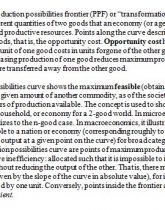Referát: Production possibility frontier (Hranica produkčných možnosti)
Skryť detaily | Obľúbený- Kvalita:82,6 %
- Typ:Referát
- Univerzita:Technická univerzita v Košiciach
- Fakulta:Ekonomická fakulta
- Kategória:Jazyky
- Podkategória:Angličtina
- Predmet:Seminár z anglického jazyka
- Autor:mofisto
- Ročník:2. ročník
- Rozsah A4:3 strán
- Zobrazené:1 877 x
- Stiahnuté:1 x
- Veľkosť:0,1 MB
- Formát a prípona:MS Office Word (.doc)
- Jazyk:anglický
- ID projektu:13743
- Posledna úprava:14.06.2021
In economics, a production possibilities frontier (PPF) or “transformation curve” is a graph that shows the different quantities of two goods that an economy (or agent) could efficiently produce with limited productive resources. Points along the curve describe the trade-off between the two goods, that is, the opportunity cost. Opportunity cost here measures how much an additional unit of one good costs in units forgone of the other good. The curve illustrates that increasing production of one good reduces maximum production of the other good as resources are transferred away from the other good.
The production possibilities curve shows the maximum feasible (obtainable) amount of one commodity for any given amount of another commodity, as of the society's technology and the amount of factors of production available. The concept is used to show the options open to a firm, individual, household, or economy for a 2-good world. In microeconomics, the 2-good case readily generalizes to the n-good case. In macroeconomics, it illustrates the production possibilities available to a nation or economy (corresponding roughly to macroeconomic notions of potential output at a given point on the curve) for broad categories of output. All points on a production possibilities curve are points of maximum productive efficiency or minimum productive inefficiency: allocated such that it is impossible to increase the output of one commodity without reducing the output of the other.
...
The production possibilities curve shows the maximum feasible (obtainable) amount of one commodity for any given amount of another commodity, as of the society's technology and the amount of factors of production available. The concept is used to show the options open to a firm, individual, household, or economy for a 2-good world. In microeconomics, the 2-good case readily generalizes to the n-good case. In macroeconomics, it illustrates the production possibilities available to a nation or economy (corresponding roughly to macroeconomic notions of potential output at a given point on the curve) for broad categories of output. All points on a production possibilities curve are points of maximum productive efficiency or minimum productive inefficiency: allocated such that it is impossible to increase the output of one commodity without reducing the output of the other.
...


